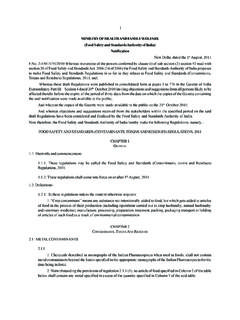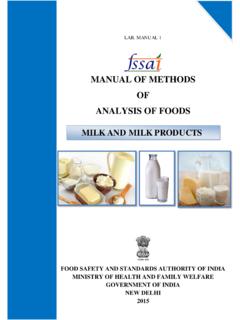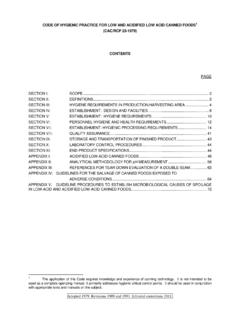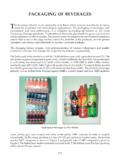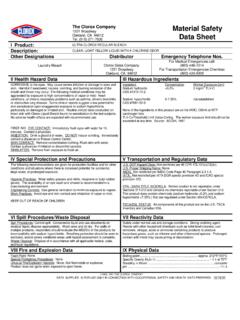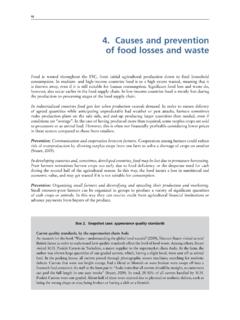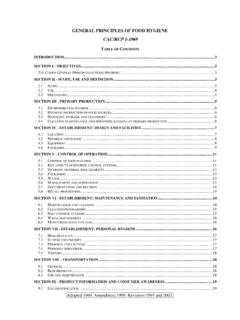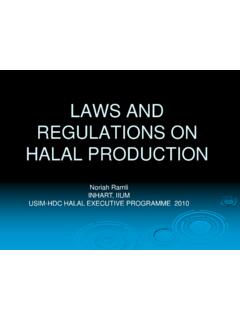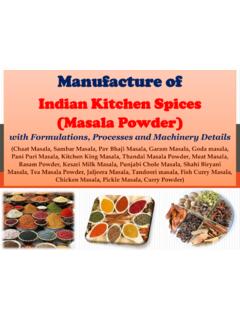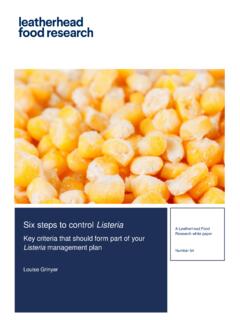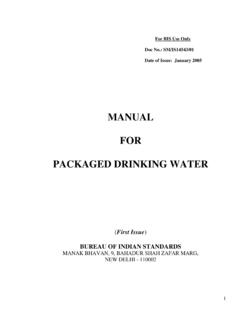Transcription of CONCEPTS OF FOOD SAFETY AND QUALITY MANAGEMENT …
1 CONCEPTS OF FOOD SAFETY . AND. QUALITY MANAGEMENT SYSTEMS. Mrs. Malini Rajendran JUNE-2010 FSSAI Malini Rajendran -Director MIECOFT. REGULATORS TRAINING CONSULTANTS. Brief background 1963 - The Codex Alimentarius Commission was created by FAO and WHO to develop food standards, guidelines and related texts. 1969 - The Codex Alimentarius Commission brought out the Recommended International Code of Practice-General Principles of Food Hygiene GHP which has undergone four revisions . Ver 4. 2005- The ISO (International Organization for Standardization) stepped in and brought out ISO. 22000:2005 . Harmonize on a global level, Food SAFETY MANAGEMENT systems - Requirements for any organization in the food chain. JUNE-2010 FSSAI Malini Rajendran -Director MIECOFT. REGULATORS TRAINING CONSULTANTS. Food SAFETY standards : CODEX. Primary objective food is safe and suitable for human consumption. Ensuring fair trade practices in the food trade.
2 Follows the food chain farm to fork. Takes into account the wide diversity of activities and varying degrees of risk involved in food production . Lays a firm foundation for ensuring food hygiene with each specific code of hygiene practice applicable to each sector. JUNE-2010 FSSAI Malini Rajendran -Director MIECOFT. REGULATORS TRAINING CONSULTANTS. CODEX ALIMENTARIUS. Codex recommends a HACCP based approach wherever possible to enhance food SAFETY as desired. HACCP ( Hazard Analysis And Critical Control Point). Codex guidelines and HACCP. approach forms the core of the entire food SAFETY program . JUNE-2010 FSSAI Malini Rajendran -Director MIECOFT. REGULATORS TRAINING CONSULTANTS. Food SAFETY standards : ISO 22000. Since ISO 22000 is a generic food SAFETY MANAGEMENT standard. It can be used by any organization directly or indirectly involved in the food chain. It applies to all organizations in the food chain.
3 It doesn't matter how complex the organization is or what size it is, ISO 22000 can help ensure the SAFETY of its food products. JUNE-2010 FSSAI Malini Rajendran -Director MIECOFT. REGULATORS TRAINING CONSULTANTS. Food SAFETY standards : ISO 22000. An ideal food SAFETY MANAGEMENT system: Meets the food SAFETY policy and achieve the measurable objectives related to the policy Meets performance of effectiveness (extent to which planned activities are realized and planned results achieved) and efficiency (relationship between the results achieved and the resources needed). Applies proven MANAGEMENT principles aimed at continually improving performance over the long term by focusing on customers while addressing the needs of all other stakeholders. An effective FSMS should be one that: Is well-established, documented, implemented, maintained and continually improved / updated. Has its products / services that actually meet its intended usage and are safe.
4 Is proactive and innovative, scientific, risk-avoiding and prevention- oriented JUNE-2010 FSSAI Malini Rajendran -Director MIECOFT. REGULATORS TRAINING CONSULTANTS. Food SAFETY standards : ISO 22000. ISO 22000 integrates the Codex Alimentarius Commission's 7 principles of HACCP and dynamically combine it with PRPs necessary to control and reduce any food SAFETY hazards. PRPs (PRE-REQUISITE PROGRAM) are also referred to as good hygienic practices(GHP), good agricultural practices, good production practices, good manufacturing practices(GMP), good distribution practices, and good trading practices. JUNE-2010 FSSAI Malini Rajendran -Director MIECOFT. REGULATORS TRAINING CONSULTANTS. CODEX ALIMENTARIUS. & ISO 22000. EIGHT GENERAL PRINCIPLES OF. FOOD HYGIENE. Pre-requisite program with specific hygiene standards. 41codes of hygienic and technological practices. ( product specific and process specific).
5 SEVEN PRINCIPLES OF HACCP. SYSTEM. JUNE-2010 FSSAI Malini Rajendran -Director MIECOFT. REGULATORS TRAINING CONSULTANTS. ISO 22000. 8 6 7. Preliminary HACCP. PRP steps Review GHP Of GMP HACCP. Requires MANAGEMENT to commit &. communicate JUNE-2010 FSSAI Malini Rajendran -Director MIECOFT. REGULATORS TRAINING CONSULTANTS. PRP GHP/GMP. production Design and facilities Eight Principals of Hygiene 3. Control of 7. Product GHP operations information and Throughout the consumer awareness food chain and sanitation 5. Personnel Hygiene JUNE-2010 FSSAI Malini Rajendran -Director MIECOFT. REGULATORS TRAINING CONSULTANTS. Definition of Food Chain Sequence of stages and operations involved in production , processing, distribution, storage & handling of a food & food ingredients from primary production to consumption. JUNE-2010 FSSAI. REGULATORS TRAINING. PRP PRE-REQUISITE PROGRAM. EIGHT GENERAL PRINCIPLES OF FOOD HYGIENE- GHP.
6 1. Primary production 2. Establishment Design and Facilities 3. Control of operations 4. Maintenance and sanitation 5. Personal Hygiene 6. Transportation 7. Product information and consumer awareness 8. Training JUNE-2010 FSSAI Malini Rajendran -Director MIECOFT. REGULATORS TRAINING CONSULTANTS. Foundation of Food SAFETY IMPROVEMENT AND MAINTENANCE. TRAINING. QUALITY RAW MATERIALS AND production . PROCESS, STORAGE, PACKAGING AND DELIVERY. INFRASTRUCTURE AND HYGIENE. JUNE-2010 FSSAI Malini Rajendran -Director MIECOFT. REGULATORS TRAINING CONSULTANTS. PRP PRE-REQUISITE PROGRAM. EIGHT GENERAL PRINCIPLES OF FOOD HYGIENE-GHP. 1. Primary production Environmental hygiene (where the environment/. surrounding poses a threat to food SAFETY ). hygienic production of Food Sources (Control contamination from air, soil, water, feed-stock, pesticides, veterinary drugs or any other agent used in primary production .)
7 Protect food sources from fecal and other contaminant). Handling storage and transport (Use appropriate storage materials and equipment. Protect food and food ingredients from contamination by pests, chemicals, microbiological or physical or other objectionable substances during handling storage and transportation. Cross contamination.). Cleaning maintenance and personal hygiene. JUNE-2010 FSSAI Malini Rajendran -Director MIECOFT. REGULATORS TRAINING CONSULTANTS. PRP PRE-REQUISITE PROGRAM. EIGHT GENERAL PRINCIPLES OF FOOD HYGIENE-GHP. 2. Establishment Design and Facilities Nature of operations, associated risks . Premises and equipment and facilities to minimize risk and ensure food SAFETY Location (Potential sources of contamination from surroundings). Internal design, structures and layout of the premises rooms and equipment (Should facilitate MEASURES THAT. PREVENT CONTAMINATION, durable, movable and capable of being disassembled to allow for maintenance, cleaning, disinfecting and monitoring).
8 Facilities (Directly or indirectly impact food SAFETY : water QUALITY , air QUALITY , drainage and waste disposal, temperature control, personal hygiene, lighting, storage- ensure effective protection from contamination during storage.). Especially temporary or mobile facilities JUNE-2010 FSSAI Malini Rajendran -Director MIECOFT. REGULATORS TRAINING CONSULTANTS. PRP PRE-REQUISITE PROGRAM. EIGHT GENERAL PRINCIPLES OF FOOD HYGIENE- GHP. of Operations: Control of food hazards through the use of HACCP. system (Potential sources of contamination from surroundings, Time and Temprature). Key aspects of hygiene control systems (Specific process steps, Microbiological and other specifications, microbial cross contamination, physical and chemical contamination). Incoming material requirements( specification to be identified and applied, where possible inspected and sorted before processing). cont . JUNE-2010 FSSAI Malini Rajendran -Director MIECOFT.
9 REGULATORS TRAINING CONSULTANTS. PRP PRE-REQUISITE PROGRAM. EIGHT GENERAL PRINCIPLES OF FOOD HYGIENE-GHP. of Operations (cont.) : Packaging ( Design and materials used). Water - ( in contact with food and used as an ingredient Special care for Ice and steam). MANAGEMENT and supervision (Size of the business, nature of activity and type of food). Documentation and records (period that exceeds shelf life). Recall procedures. (complete recall, handling and communication). JUNE-2010 FSSAI Malini Rajendran -Director MIECOFT. REGULATORS TRAINING CONSULTANTS. PRP PRE-REQUISITE PROGRAM. EIGHT GENERAL PRINCIPLES OF FOOD HYGIENE-GHP. 4. Maintenance and Sanitation Cleaning methods and procedures. (Appropriate for the type of product and type of machine. Hidden residual food/pest infestation). Cleaning Programs (Method, frequency and monitored for their suitability and effectiveness). Pest Control Systems (Preventing access, preventing harborage and infestation, monitoring and detection, eradication measures).
10 Waste MANAGEMENT (Method, frequency and effectiveness). Monitoring Effectiveness (Periodic Audit, microbial sampling). JUNE-2010 FSSAI Malini Rajendran -Director MIECOFT. REGULATORS TRAINING CONSULTANTS. PRP PRE-REQUISITE PROGRAM. EIGHT GENERAL PRINCIPLES OF FOOD HYGIENE- GHP. 5. Personal Hygiene Health Status of Employees. Illness and injuries (Communicable diseases and surface injuries to hands or parts that come in contact with food items.). Personal cleanliness-Clothing Personal Behavior ( smoking, spitting, chewing and eating, sneezing , personal effects.). Visitors ( Rules and guidelines for entry and access and SAFETY or protective covering). JUNE-2010 FSSAI Malini Rajendran -Director MIECOFT. REGULATORS TRAINING CONSULTANTS. PRP PRE-REQUISITE PROGRAM. EIGHT GENERAL PRINCIPLES OF FOOD HYGIENE-GHP. Design of conveyances and bulk containers. ( Proper segregation to prevent cross contamination, Time, temperature and humidity controls available and monitored, Appropriate for type of packaging).

